信息整理:图书馆
2023年诺贝尔化学奖被授予美国化学家蒙吉·巴文迪(Moungi G. Bawendi), 美国化学家路易斯·布鲁斯(Louis E. Brus)和俄罗斯物理学家阿列克谢·叶基莫夫(Alexei I. Ekimov),以表彰他们对量子点的发现和合成作出的贡献。以下对三位诺奖得主与相关主题的学术论文和相关施引文献展开分析。
一、获奖者的发文分析
三位获奖者相关主题的SCIE论文有382篇,最早发文年限可追溯到1981年,各年度发文分布如图1所示。其中,单篇论文被引超过1000次的有21篇,单篇最高被引达到8146次。ESI高被引论文有16篇。
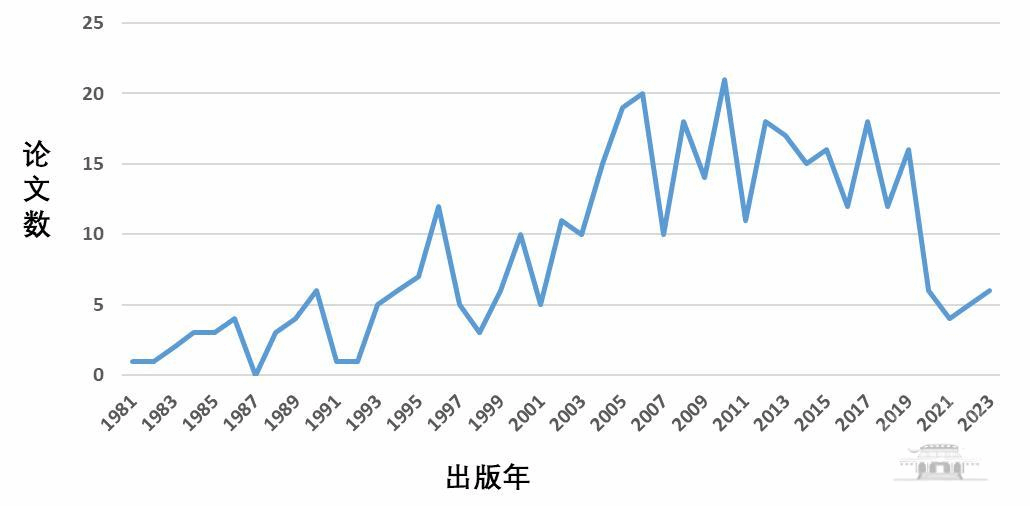
图1 2023年诺贝尔化学奖得主相关主题论文的年代分布
382篇诺贝尔奖相关主题论文,由于数据库数据不全,有12篇论文不在分析之列;表1是其余370篇论文所涉及的9个ESI学科领域及各组论文的学科影响力表现;其中材料科学领域论文131篇,占比34%,生物学及生物化学论文8篇,篇均被引高达833.5次,各组论文表现见表1。
表1 诺贝尔奖相关主题论文归属学科及影响力表现
ESI学科 |
论文数 |
被引频次 |
篇均被引 |
学科规范化的引文影响力 |
排名前1% 的论文 |
平均百分位 |
Materials Science |
131 |
26679 |
203.66 |
6.84 |
16.03 |
84.34 |
Physics |
108 |
33770 |
312.69 |
11 |
33.33 |
92.31 |
Chemistry |
108 |
31406 |
290.8 |
10.56 |
29.63 |
90.11 |
Clinical Medicine |
10 |
2127 |
212.7 |
6.74 |
20 |
91.78 |
Biology & Biochemistry |
8 |
6668 |
833.5 |
18.28 |
50 |
98.76 |
Environment/Ecology |
2 |
683 |
341.5 |
17.8 |
100 |
99.73 |
Multidisciplinary |
1 |
600 |
600 |
27.89 |
100 |
99.44 |
Molecular Biology & Genetics |
1 |
351 |
351 |
4.49 |
0 |
96.92 |
Engineering |
1 |
20 |
20 |
0.72 |
0 |
63.19 |
获奖者相关主题论文分布于78种期刊,发文量位于前3位的期刊为:Nano Letters(54篇,占比14%),Journalof the American Chemical Society(39篇,占比10%),Physical Review B(29篇,占比8%)。
三位获奖者的相关主题学术论文详见武汉大学图书馆化学学科服务平台:https://libguides.lib.whu.edu.cn/chemistry。
二、相关施引文献分析
截至2023年12月6日,三位诺贝尔化学奖得主的382篇相关文献被全球73385篇论文引用,总被引114929次,篇均被引频次为305.29。从全球来看,施引文献从1983年到2023年持续增长,2020年高达4559篇,如图2所示。全部施引文献分布在136个国家/地区,排名第一的是美国,发文量达20004篇;中国排在第二,发文量为19575篇。
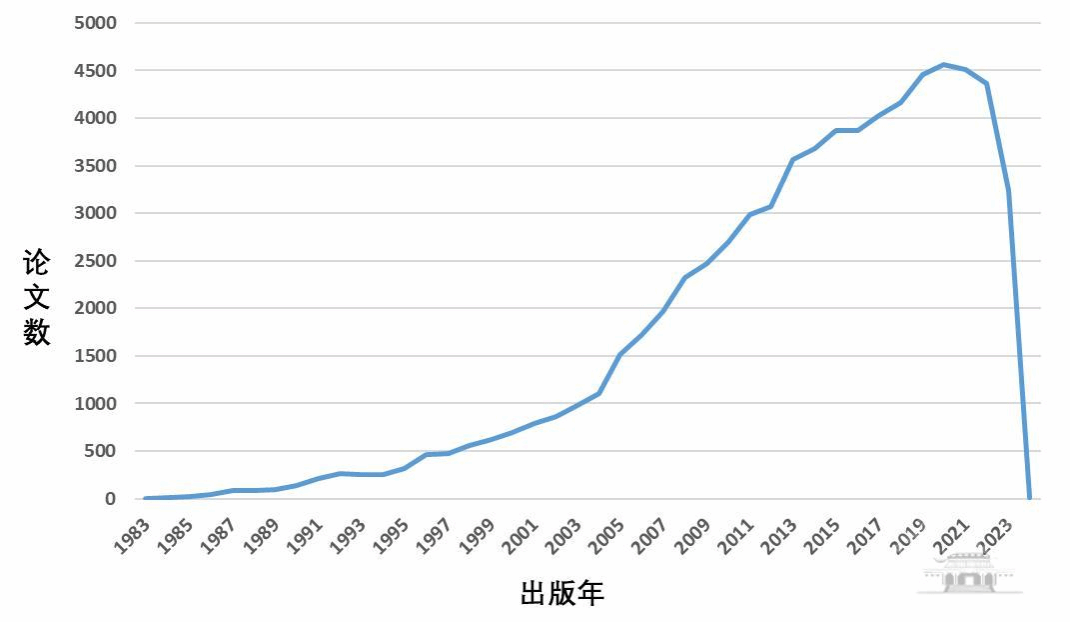
图2 2023年诺贝尔化学奖相关施引文献的年代分布
我们结合本次诺奖的获奖原因,从施引文献中筛选出与诺奖主题相关的论文共计22951篇(占全部施引文献的31%),下面从不同角度分析这些相关施引文献。
22951篇相关施引文献分布于1389种期刊,如图3所示,其中Journal of Physical Chemistry C占比5%,Nano Letters占比3%,Physical Review B占比3%。相关施引文献量TOP20期刊见图3。
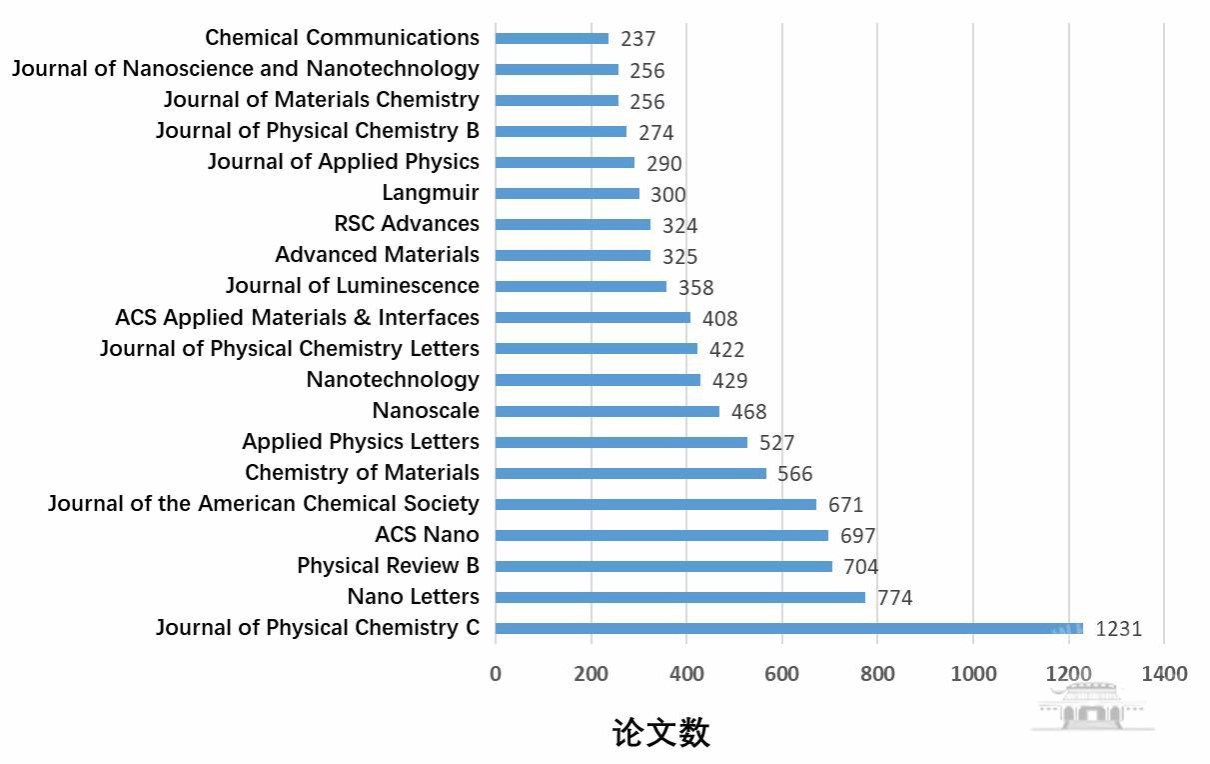
图3 2023年诺贝尔化学奖相关施引文献期刊分布(TOP20)
22951篇相关施引文献涉及全球108个国家/地区,其中中国作者参与的相关施引文献共计6092篇,居全球第二,施引文献量TOP10机构排名如图4所示。

图4 2023年诺贝尔化学奖相关施引文献量Top10的中国机构
根据对相关主题施引文献的关键词的词频统计,得到高频关键词词云,出现频率最高的包括量子点(7947次)、光学特性(2291次)、太阳能电池(1375次)、硒化镉量子点(1249次)、胶体量子点(1147次)、量子产率(1020次)、半导体纳米微晶(760次)、量子限域(742次)、碲化镉量子点(719次)、水溶液(707次)等。详见图5。
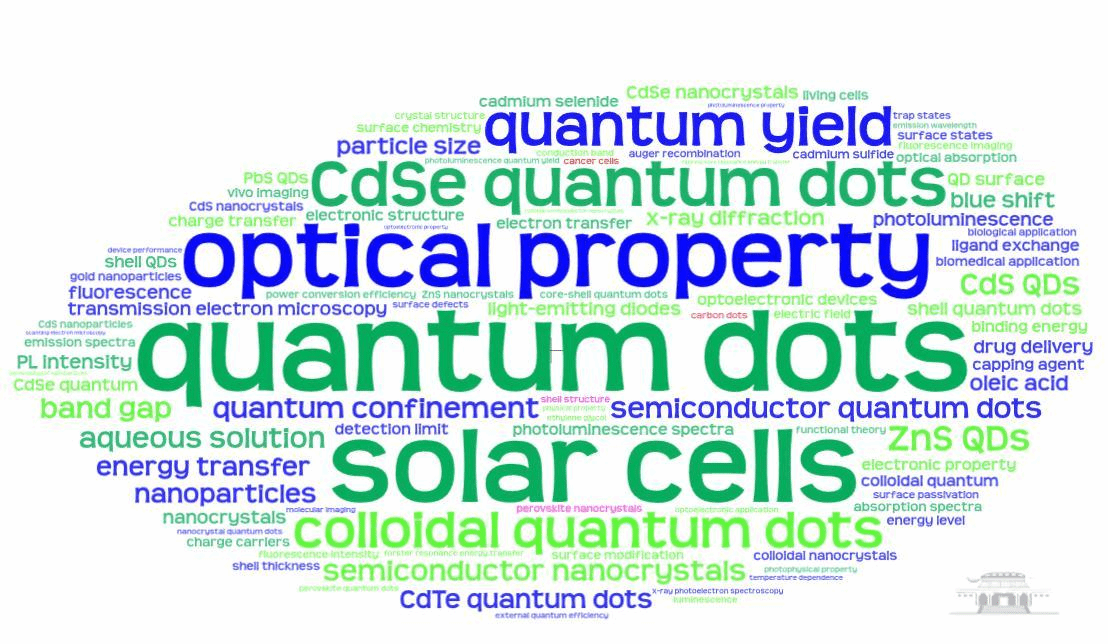
图5 2023年诺贝尔化学奖相关施引文献高频关键词词云图
从三位获奖者382篇主题相关文献词频来看,主要高频词及频率为量子点(81次)、太阳能电池(23次)、胶体量子点(18次)、硒化镉纳米晶(13次)、硒化镉量子点(12次)等,如图6所示。
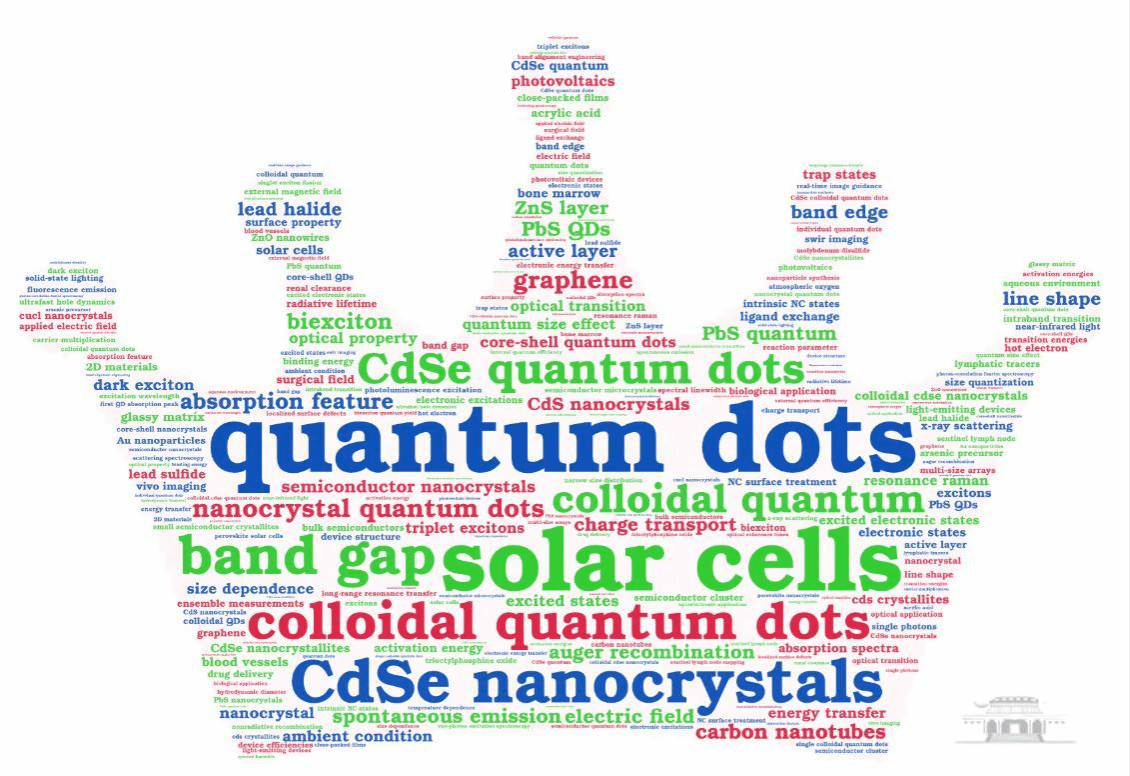
图6 2023年诺贝尔化学奖相关主题文献的高频关键词词云图
图7为关键词共现聚类时线图,该图通过关键词共现的频次反映主题间的关系以及时间发展情况,可见2019年以来施引文献的关键词聚类主要集中在癌细胞、瞬态吸收、光催化活性、太阳能电池、发光二极管、钙钛矿纳米晶、硫化锌量子点和发光强度等,详见图7。
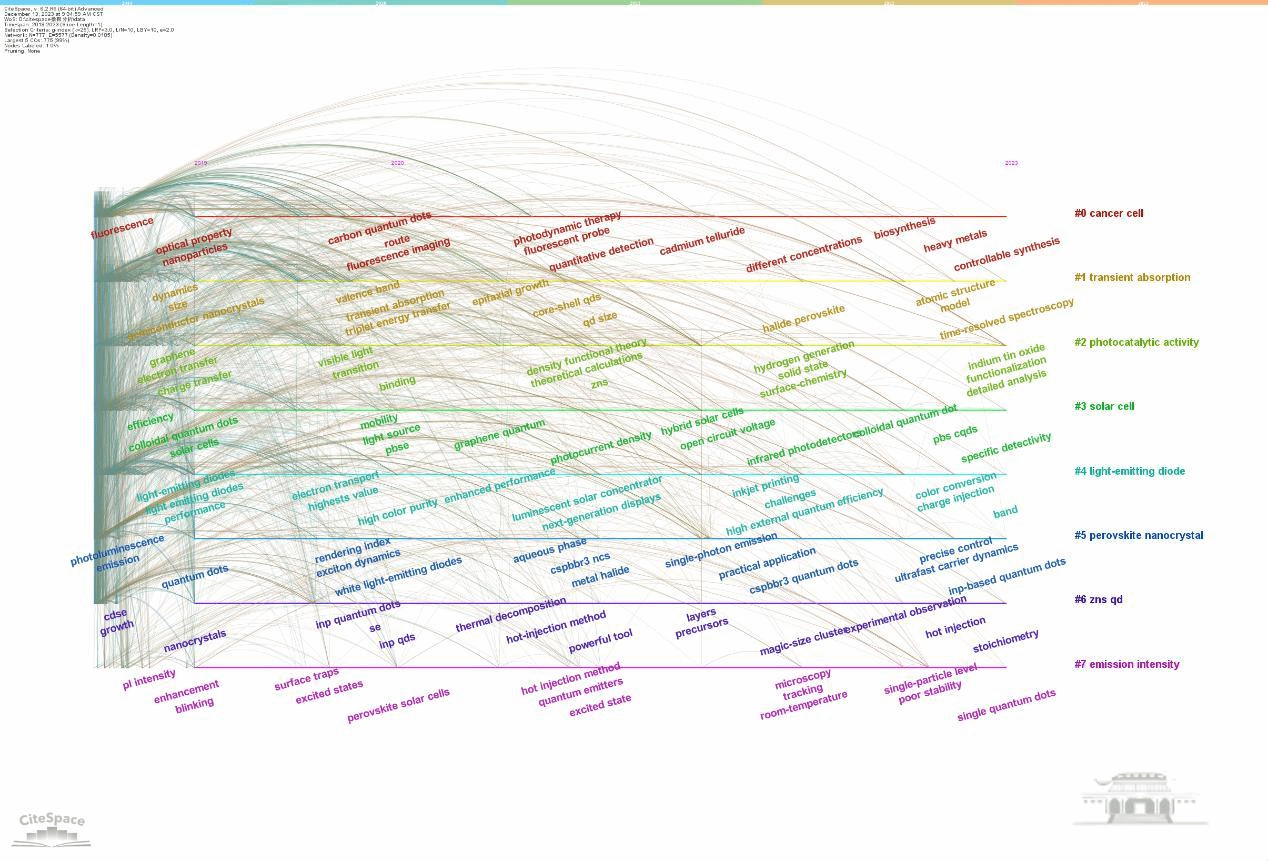
图7 2023年诺贝尔化学奖2019-2023年相关施引文献的关键词聚类时线图
三、相关主题高影响力论文
近10年的诺贝尔获奖者相关主题学术论文中,ESI高被引论文16篇,论文信息如下,中国机构为第一作者单位的论文见文献16。
[1] Yost S R, Lee J, Wilson M W B, et al.A Transferable Model for Singlet-Fission Kinetics[J]. Nature Chemistry, 2014, 6(6): 492-497.
[2] Yoo J J, Wieghold S, Sponseller M C, et al.An Interface Stabilized Perovskite Solar Cell with High Stabilized Efficiency and Low Voltage Loss[J]. Energy & Environmental Science, 2019, 12(7): 2192-2199.
[3] Yoo J J, Seo G, Chua M R, et al.Efficient Perovskite Solar Cells via Improved Carrier Management[J]. Nature, 2021, 590(7847): 587-593.
[4] Yaffe O, Guo Y S, Tan L Z, et al.Local Polar Fluctuations in Lead Halide Perovskite Crystals[J/OL]. Physical Review Letters, 2017, 118(13) (2017-03-28) [2023-12-20]https://journals.aps.org/prl/abstract/10.1103/PhysRevLett.118.136001#fulltext.
[5] Wu M F, Congreve D N, Wilson M W B, et al.Solid-State Infrared-to-Visible Upconversion Sensitized by Colloidal Nanocrystals[J]. Nature Photonics, 2016, 10(1): 31-34.
[6] Wei H, Bruns O T, Kaul M G, et al.Exceedingly Small Iron Oxide Nanoparticles as Positive MRI Contrast Agents[J]. Proceedings of the National Academy of Sciences of the United States of America, 2017, 114(9): 2325-2330.
[7] Utzat H, Sun W W, Kaplan A E K, et al.Coherent Single-Photon Emission from Colloidal Lead Halide Perovskite Quantum Dots[J]. Science, 2019, 363(6431): 1068-1072.
[8] Turren-Cruz S H, Saliba M, Mayer M T, et al.Enhanced Charge Carrier Mobility and Lifetime Suppress Hysteresis and Improve Efficiency in Planar Perovskite Solar Cells[J]. Energy Environment Science, 2018, 11(1): 78-86.
[9] Raja A, Chaves A, Yu J, et al.Coulomb Engineering of the Bandgap and Excitons in Two-Dimensional Materials[J/OL]. Nature Communications, 2017, 8(2017-05-04) [2023-12-20]https://www.nature.com/articles/ncomms15251.
[10] Hoye R L Z, Brandt R E, Osherov A, et al.Methylammonium Bismuth Iodide as a Lead-Free, Stable Hybrid Organic-Inorganic Solar Absorber[J]. Chemistry-A European Journal, 2016, 22(8): 2605-2610.
[11] Einzinger M, Wu T, Kompalla J F, et al.Sensitization of Silicon by Singlet Exciton Fission in Tetracene[J/OL]. Nature, 2019, 571(7763) (2019-07-03) [2023-12-20]https://www.nature.com/articles/s41586-019-1339-4.
[12] Chuang C H M, Brown P R, Bulovic V, et al.Improved Performance and Stability in Quantum Dot Solar Cells through Band Alignment Engineering[J]. Nature Materials, 2014, 13(8): 796-801.
[13] Chen O, Zhao J, Chauhan V P, et al.CompactHigh-Quality CdSe-CdS Core-Shell Nanocrystals with Narrow Emission Linewidths and Suppressed Blinking[J]. Nature Materials, 2013, 12(5): 445-451.
[14] Bruns O T, Bischof T S, HarrisD K, et al.Next-Generation in Vivo Optical Imaging with Short-Wave Infrared Quantum Dots[J/OL]. Nature Biomedical Engineering, 2017, 1(4)(2017-04-10) [2023-12-20]https://www.nature.com/articles/s41551-017-0056.
[15] Brown P R, Kim D, Lunt R R, et al.Energy Level Modification in Lead Sulfide Quantum Dot Thin Films through Ligand Exchange[J]. ACS Nano, 2014, 8(6): 5863-5872.
[16] Bao J, Bawendi M G.A Colloidal Quantum Dot Spectrometer[J/OL]. Nature, 2015, 523(7558) (2015-07-01) [2023-12-20]https://www.nature.com/articles/nature14576.
四、高影响力施引论文
2021年来相关主题施引论文中包含ESI高被引论文共23篇,论文信息如下,其中中国机构为第一作者单位的发文见文献1-3、5-7、10-16、18、19和21,ESI热点论文见10、17和23。
[1] Zhang J J, Bifulco A, Amato P, et al.Copper Indium Sulfide Quantum Dots in Photocatalysis[J]. Journal of Colloid and Interface Science, 2023, 638: 193-219.
[2] Yang H C, Li R F, Zhang Y J, et al.Colloidal Alloyed Quantum Dots with Enhanced Photoluminescence Quantum Yield in the NIR-II Window[J]. Journal of the American Chemical Society, 2021, 143(6): 2601-2607.
[3] Wei C T, Su W M, Li J T, et al.A Universal Ternary-Solvent-Ink Strategy toward Efficient Inkjet-Printed Perovskite Quantum Dot Light-Emitting Diodes[J/OL]. Advanced Materials, 2022, 34(10)(2022-01-06) [2023-12-20]https://onlinelibrary.wiley.com/doi/10.1002/adma.202107798.
[4] Wang F F, Ren F Q, Ma Z R, et al.In Vivo Non-Invasive Confocal Fluorescence Imaging beyond 1,700 nm Using Superconducting Nanowire Single-Photon Detectors[J/OL]. Nature Nanotechnology, 2022, 17(6)(2022-05-23) [2023-12-20]https://www.nature.com/articles/s41565-022-01130-3.
[5] Wang B Y, Wei Z H, Sui L Z, et al.Electron-Phonon Coupling-Assisted Universal Red Luminescence of O-Phenylenediamine-Based Carbon Dots[J]. Light-Science Applications, 2022, 11(1): 172.
[6] Wan Q, Zheng W L, Zou C, et al.Ultrathin Light-Emitting Diodes with External Efficiency over 26% Based on Resurfaced Perovskite Nanocrystals[J]. ACS Energy Letters, 2023, 8(2): 927-934.
[7] Tian B S, Liu S H, Yu C H, et al.A Metal-Free Mesoporous Carbon Dots/Silica Hybrid Type I Photosensitizer with Enzyme-Activity for Synergistic Treatment of Hypoxic Tumor[J/OL]. Advanced Functional Materials, 2023, 33(25)(2023-03-10) [2023-12-20]https://onlinelibrary.wiley.com/doi/10.1002/adfm.202300818.
[8] Tamarat P, Prin E, Berezovska Y, et al.Universal Scaling Laws for Charge-Carrier Interactions with Quantum Confinement in Lead-Halide Perovskites[J/OL]. Nature Communications, 2023, 14(1)(2023-01-16) [2023-12-20]https://www.nature.com/articles/s41467-023-35842-4.
[9] Raj S, Khurana S, Choudhari R, et al.Specific Targeting Cancer Cells with Nanoparticles and Drug Delivery in Cancer Therapy[J]. Seminars in Cancer Biology, 2021, 69: 166-177.
[10] Meng T T, Zheng Y T, Zhao D L, et al.Ultrahigh-Resolution Quantum-Dot Light-Emitting Diodes[J/OL]. Nature Photonics, 2022, 16(4)(2022-02-28) [2023-12-20]https://www.nature.com/articles/s41566-022-00960-w.
[11] Mei X Y, Jia D L, Chen J X, et al.Approaching High-Performance Light-Emitting Devices upon Perovskite Quantum Dots: Advances and Prospects[J/OL]. Nano Today, 2022, 43(2022-03-14) [2023-12-20]https://www.sciencedirect.com/science/article/pii/S1748013222000767?via%3Dihub.
[12] Liu Y C, Chen T, Jin Z K, et al.Tough, Stable and Self-Healing Luminescent Perovskite-Polymer Matrix Applicable to All Harsh Aquatic Environments[J/OL]. Nature Communications, 2022, 13(1)(2022-03-14) [2023-12-20]https://www.nature.com/articles/s41467-022-29084-z.
[13] Liu M M, Wan Q, Wang H M, et al.Suppression of Temperature Quenching in Perovskite Nanocrystals for Efficient and Thermally Stable Light-Emitting Diodes[J]. Nature Photonics, 2021, 15(5): 379-385.
[14] LI L, Cheng J S, Cheng Y Y, et al.Significant Improvements in Dielectric Constant and Energy Density of Ferroelectric Polymer Nanocomposites Enabled by Ultralow Contents of Nanofillers[J/OL]. Advanced Materials, 2021, 33(35)(2021-07-24) [2023-12-20]https://onlinelibrary.wiley.com/doi/10.1002/adma.202102392.
[15] LI H Y, Zhang W J, Bian Y Y, et al.ZnF2-Assisted Synthesis of Highly Luminescent InP/ZnSe/ZnS Quantum Dots for Efficient and Stable Electroluminescence[J]. Nano Letters, 2022, 22(10): 4067-4073.
[16] LI B L, Zhao S J, Huang L, et al.Recent Advances and Prospects of Carbon Dots in Phototherapy[J/OL]. Chemical Engineering Journal, 2021, 408(2021-03-15) [2023-12-20]https://www.sciencedirect.com/science/article/pii/S1385894720333702?via%3Dihub.
[17] Kim M, Jeong J, Lu H Z, et al.Conformal Quantum Dot-SnO2Layers as Electron Transporters for Efficient Perovskite Solar Cells[J]. Science, 2022, 375(6578): 302-306.
[18] Jiang Y Z, Cui M H, LI S S, et al.Reducing The Impact of Auger Recombination in Quasi-2D Perovskite Light-Emitting Diodes[J/OL].Nature Communications, 2021, 12(1)(2021-01-12) [2023-12-20]https://www.nature.com/articles/s41467-020-20555-9.
[19] Guo J Z, Lu Y S, Xie A Q, et al.Yellow-Emissive Carbon Dots with High Solid-State Photoluminescence[J/OL]. Advanced Functinal Materials, 2022, 32(20)(2022-02-09) [2023-12-20]https://onlinelibrary.wiley.com/doi/10.1002/adfm.202110393.
[20] Cherniukh I, Rainò G, Stöferle T, et al.Perovskite-Type Superlattices from Lead Halide Perovskite Nanocubes[J]. Nature, 2021, 593(7860)(2021-05-26) [2023-12-20]https://www.nature.com/articles/s41586-021-03492-5.
[21] Chen X T, Lin X F, Zhou L K, et al.Blue Light-Emitting Diodes Based on Colloidal Quantum Dots with Reduced Surface-Bulk Coupling[J/OL]. Nature Communications, 2023, 14(1)(2023-01-17) [2023-12-20]https://www.nature.com/articles/s41467-023-35954-x.
[22] Ameen A A, Al-dossari M, Zaky Z A, et al.Studying the Effect of Quantum Dots and Parity-Time Symmetry on the Magnification of Topological Edge State Peak as a Pressure Sensor[J/OL]. Synthetic Metals, 2023, 292(2022-11-21) [2023-12-20]https://www.sciencedirect.com/science/article/pii/S0379677922002272?via%3Dihub.
[23] Akkerman Q A, Nguyen T P T, Boehme S C, et al.Controlling the Nucleation and Growth Kinetics of Lead Halide Perovskite Quantum Dots[J]. Science, 2022, 377(6613): 1406-1412.
因学科(专业)所限,错误在所难免,敬请批评指正!同时,也面向全校师生征集关注的领域和专题,欢迎提出宝贵建议。联系方式:68754550,Email:jflai@lib.whu.edu.cn。
(编辑:陈爱群、张小娥 审核:刘颖)
